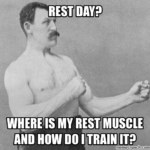
Words by Heather Cole
Recovery is something I have a love/hate relationship with. As in, I need to love it but I mostly hate it. I am the kind of person that likes to be operating in 110% mode all the time. I was successfully managing to work more than full-time hours while doing school part time, and training for long distance triathlon all while dealing with my Type 1, or so I thought. I ignored all the warning signs my body gave me and ended up crashing and burning. My body was falling apart, all of my training sessions felt heavy and slow, and I found myself in the early stages of overtraining syndrome. After taking some time off training and really refocusing, I’ve gotten back to loving training and allowing my body the rest and recovery it needs. Here are some ways to incorporate rest and recovery into your training routine to avoid learning the hard way like me.
Sleep
If you’re anything like me, you probably have more things scheduled in your day than hours available. In order to fit everything in, I was always cutting back on sleep because it was the easiest thing to do. Sleep is the most important part of recovery because it gives your body a chance to repair itself. One of the things that have worked really well for me is to set a reasonable bedtime and not break it. Set a bedtime alarm if you have to. If I end up working late and have limited time in the evening, rather than cutting back my sleep, I cut back my training a little or shuffle my workouts around to do it on another day.
Bend So You Don’t Break
Flexibility and mobility help you stay injury free and your body recover. I enjoy yoga, but I found that I had a hard time committing to going on a regular basis, I always somehow ended up on my bike instead. I signed up for a registered mobility class at my local rec center.
This allows me to go run intervals before the class so I don’t feel like I’m sacrificing training. I also have a yoga mat on my bedroom floor. I stretch, foam roll, and use the lacrosse ball before I go to bed. Here’s an article from Runner’s World on foam rolling if you aren’t familiar.
Active Recovery
My coach has me work on a 3-week build, 1-week active recovery plan. In recovery week the workouts are shorter and less intense. This allows my body a chance to recover, and come back even stronger for the next build phase. Fight the temptation to add additional workouts and intensity during this active recovery week.
active recovery plan. In recovery week the workouts are shorter and less intense. This allows my body a chance to recover, and come back even stronger for the next build phase. Fight the temptation to add additional workouts and intensity during this active recovery week.
Listen to Your Body
This is absolutely critical. Don’t ignore warning signs that you might be feeling run down or you need a day off. I have found more often than not pushing through it sets me back far more than just taking some time off.
About Heather Cole
 Heather Cole was diagnosed with Type 1 Diabetes in the middle of her second year of University. At the time she was living in the middle of nowhere, Alberta for an engineering co-op work term, and shortly after found her love for running as more than competitive sports warm up. She now works as a Chemical Engineer, and trains for both road and offroad triathlons and running races.
Heather Cole was diagnosed with Type 1 Diabetes in the middle of her second year of University. At the time she was living in the middle of nowhere, Alberta for an engineering co-op work term, and shortly after found her love for running as more than competitive sports warm up. She now works as a Chemical Engineer, and trains for both road and offroad triathlons and running races.




